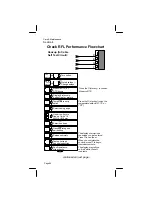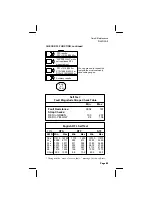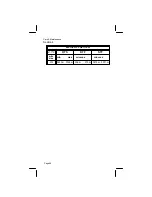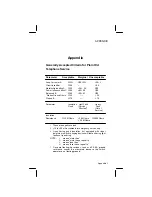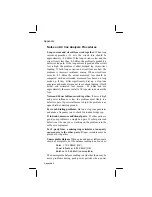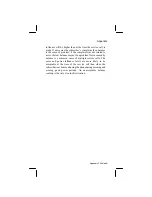
Specifications
Section 3
Page 73
Measurements continued...
Function
Range
Resolution
Accuracy
Ground
Resistance:
0 to 500 ohms
1 Ohm
3 ohms
Loop and C.O.
Resistance:
0 to 5000 ohms
1 Ohm
+10% +
50 ohms
(read through the REG key assuming on-hook resistance is known)
Caller I.D.
Option:
–4 dBm to –32 dBm
Note: 1
Perform a self-calibration before taking the readings.
2
C-message specifications have an additional frequency-
dependent tolerance. Refer to “IEEE Standard 743-1984.”
The 965/965M far exceeds these tolerances. For most
frequencies the total error is less than 0.7 dB.
3
The optional longitudinal balance function obtains a result
in agreement with “IEEE STANDARD 455-1985 Standard
Test Prodedure for Measuring Longitudinal Balance for
Telephone Equipment Operating in the Voice Band” at the
specified tolerance for power influence less than
approximately 80 dBrnc. When power influence is above
80 dBrnc, the test set reverts to a hybrid of the IEEE
method and the method of calculating longitudinal balance
by taking the difference between power influence and
noise metallic.
4
The splits function does not have accuracy tolerances.
B. Resistance Fault Locate
Note: Accuracy is dependent on power influence noise; the resistance
fault specifications are for low noise situations.
Function
Range Resolution Accuracy
1,2
Fault Range:
Up to 30 Mohms
Resistance to Fault:
3
0 to 9 ohms
0.01 Ohm
+0.1% RTS
+0.01 Ohm
(@ 70
°
no noise)
10 to 99 ohms
0.01 Ohm
+0.1% RTS
+0.01 Ohm
100 to 999 ohms
0.1 Ohm
+0.2% RTS
1k to 7 kohms
1.0 Ohm
+1.0% RTS
Resistance to Distance Conversion
Resolution:
3
1 ft to 1,000 ft
0.1 ft
1k ft to 10k ft
1.0 ft
10k ft to 100k ft
10.0 ft
1 to 99 m
0.1 m
100 to 999 m
1.0 m
1000 to 30000 m10.0 m
Temperature Sensor: 0
°
to 140
°
F
1
°
F
+2
°
F
–18
°
to 60
°
C
.5
°
C
+1
°
C
Noise Immunity:
7VAC limit for all frequencies

























